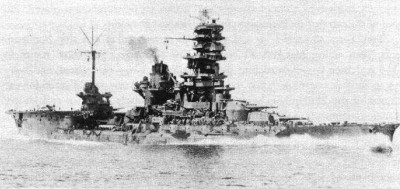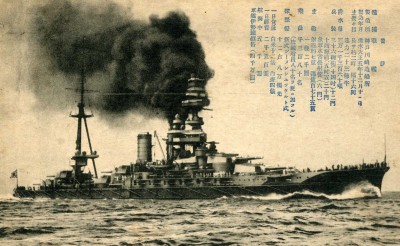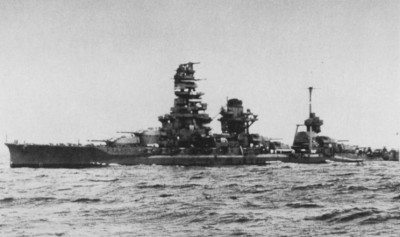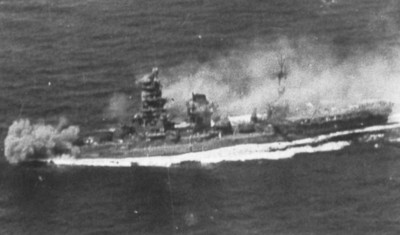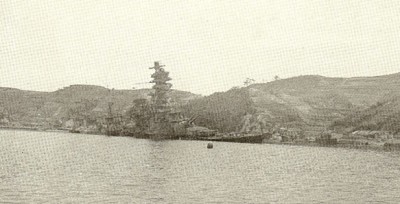| Name / Name : | - | |
| Type / Type : | battleship | |
| Class / Class : | Ise | |
| codename / Pennant number : | - | |
| the Founding of the keel / Laid down : | 10.05.1915 | |
| Run to the water / Launched : | 12.11.1916 | |
| entry into service / commissioned've : | 15.12.1917 | |
| the removal from service / End of service : | destroyed 28.07.1945 in Ondo Seto | |
| Shipyard / Built by : | Kawasaki Jukogyo Kabushiki-gaisha in Kobe, Japan | |
| Length / Length : (m) | 208,18 from march 1937: 215,80 from August 1943: 219,62 | |
| Width / Beam : (m) | 28,65 from march 1937: 33,83 | |
| Draught / Draft : (m) | 8,75 from march 1937: 9,21 from August 1943: 9,03 | |
| the Displacement of the standard / Displacement, standard : (t) | 29980 from march 1937: 35800 from August 1943: 35550 | |
| a Displacement of the maximum / Displacement, maximal : (t) | 36500 from march 1937: 40169 from August 1943: 38676 | |
| Armament / Armament : | 12x 356 mm/45 type 41 (6xII) 20x 140 mm/50 (20xI) 12x 120 mm 3x 76 mm/40 (3xI) 6x torpédomet 533 mm (6xI) from February 1932: 12x 356 mm/45 type 41 (6xII) 18x 140 mm/50 (18xI) 8x 127 mm/40 type 89 ((AA/4xII) 4x 40 mm Vickers (AA/2xII) 6x torpédomet 533 mm (6xI) from march 1937: 12x 356 mm/45 type 41 (6xII) 16x 140 mm/50 (16xI) 8x 127 mm/40 type 89 ((AA/4xII) 20x 25 mm/60 type 96 ((AA/10xII) from August 1943: 8x 356 mm/45 type 41 (4xII) 16x 127 mm/40 ((AA/8xII) 57x 25 mm/60 type 96 ((AA/19xIII) from June 1944: 8x 356 mm/45 type 41 (4xII) 16x 127 mm/40 ((AA/8xII) 104x 25 mm/60 type 96 ((AA/31xIII,11xI) from October 1944: 8x 356 mm/45 type 41 (4xII) 16x 127 mm/40 ((AA/8xII) 104x 25 mm/60 type 96 ((AA/31xIII,11xI) 6x rocket habitat 120 mm (AA/6x XXX) | |
| accessories and equipment / Equipment : | from February 1932: 1x air catapult from may 1942 to: 1x air catapult 1x radar 21 Gō - to search for airborne targets from August 1943: 2x air catapult 1x aerial lift / elevator 1x radar 21 Gō - to search for airborne targets 2x radar 22 Gō - to search for surface targets from June 1944: 2x air catapult 1x aerial lift / elevator 1x radar 21 Gō - to search for airborne targets 2x radar 22 Gō - to search for surface targets 2x infrared IFF device type 2 from July 1944: 2x air catapult 1x aerial lift / elevator 2x radar 13 Gō - to search for airborne targets 2x radar 22 Gō - to search for surface targets 2x infrared IFF device type 2 from November 1944: 1x aerial lift / elevator 2x radar 13 Gō - to search for airborne targets 2x radar 22 Gō - to search for surface targets 2x infrared IFF device type 2 | |
| Armor / Armour : (mm) | hips: 102 - 305 deck: up to 152 the forehead of the gun turrets: 305 sides of the gun turrets: 254 casemates: 152 command tower: 305 from march 1937: hips: 305 main deck: 56 armor deck: 82 a deck above muničními stores: 167 the forehead of the gun turrets: 305 sides of the gun turrets: 254 casemates: 152 command tower: 305 | |
| Propulsion / Engines : | 4x steam turbines, Brown-Curtis 24x combination boiler Kampon from march 1937: 4x steam turbine Kampon 8x boiler Kampon | |
| Power / Power : (SHP) | 45000 from march 1937: 80000 | |
| Screws / Propellers : (pcs) | 4 | |
| Speed / Speed : (kts) | 23 from march 1937: 24,5 | |
| fuel Supply / Fuel : (t) | 1300 (heavy oil) 4000 (charcoal) from march 1937: 5113 (heavy oil) from August 1943: 4249 (heavy oil) | |
| Range/Range : (miles/kts) | 9680/14 from march 1937: 7870/16 from August 1943: 9500/16 | |
| Aircraft / Aircraft : | from June 1933: 3x seaplane (Nakadžima E4N2: 1933-1938, Nakadžima E8N1 type 95 Dave: 1938-1943) from August 1943: to 22 (never been carried) | |
| Crew / Crew : | 1360 from march 1937: 1385 from August 1943: 1463 | |
| Note / Note : | the origin of the name: a province in the south-east of Japan The battleship Ise has undergone during his career, several major reconstructions. The first of them, in the years 1928-1929, changed mainly the appearance of the superstructure - the boat got pagodovitou superstructure typical for the majority of the japanese battleships. The second conversion, from the 01.08.1935 to 23.03.1937, include in particular the exchange of the propulsion machinery and the modernisation of equipment. Third, the most fundamental rebuilding,from February to October 1943, changed the ship to a hybrid battleship and aircraft carrier. At the rear, instead of the gun turrets, was installed aviation deck and hangar. The ship could carry up to 22 aircraft, but due the lack of trained pilots for their use, never took place | |
Resources:
PEJČOCH, Ivo, SMITH, David, HÁJEK, Tomáš: ships of War[4]. 1.release. Prague: Naše vojsko s. p. 1993. 374s. ISBN 80-206-0357-3
HYNEK, Vladimir, a BOY, Peter, ŠKŇOUŘIL, Eugene: ships of War[3]. 1.release. Prague: Naše vojsko s. p. 1988. 340s. ISBN 28-029-88.05/165
HRBEK, Ivan, HRBEK, Jaroslav: the Fleet of the states participating in the second world war. 1.release. Prague: Naše vojsko, 1994. 232s. ISBN 80-206-0245-3
http://combinedfleet.com
http://ww2db.com/ship_spec.php?ship_id=B28
en.wikipedia.org
http://en.wikipedia.org/wiki/Ise_class_battleship
http://de.wikipedia.org/wiki/Ise_(1917)
http://pl.wikipedia.org/wiki/Ise_(1917)
it.wikipedia.org
navalhistory.flixco.info
www.globalsecurity.org
http://homepage2.nifty.com/nishidah/e/stc0121.htm
www.battleships-cruisers.co.uk.
